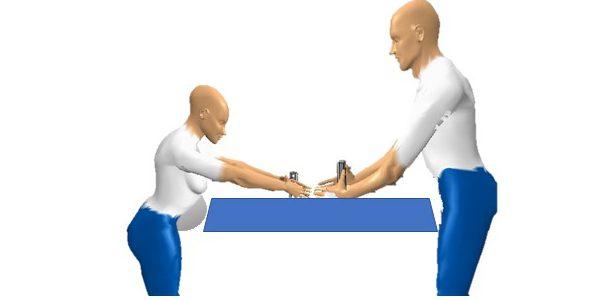Estimated reading time: 2:45
We are often asked to do assessments where forward reach turns out to be the most significant issue. Our recommendations often involve changes that look insignificant…we want to chisel away at this table, or nudge the part bin a bit closer, or reinstall two pieces of equipment closer together by a few centimeters. The responsibility for making these changes often falls to a maintenance mechanic who, with a roll of the eyes and a scratch on the head, begrudgingly complies with our wishes. We thought it might be worthwhile to show why 10 cm (4”) of reach reduction can make a difference.
Within reason, most people can extend their reach by an extra 10 cm under most conditions; workers will occasionally teeter over a rail to gain that extra distance. It’s possible, but that doesn’t mean it’s efficient, or comfortable.
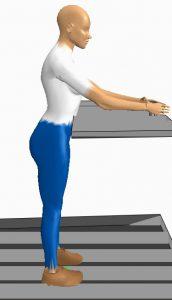 A forward reach of 50 cm, for example, is fine for an “average” female worker, with light loads in the hands (e.g. 0.45 kg per hand), a reasonable work height (e.g. 100 cm), and infrequent effort (e.g. once per hour). According to the “duty cycle” assessment (see ACGIH for details), this task is perfectly acceptable.
A forward reach of 50 cm, for example, is fine for an “average” female worker, with light loads in the hands (e.g. 0.45 kg per hand), a reasonable work height (e.g. 100 cm), and infrequent effort (e.g. once per hour). According to the “duty cycle” assessment (see ACGIH for details), this task is perfectly acceptable.
50 cm + 0.45 kg per hand + once per hour = acceptable
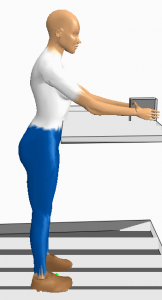 Add some weight (e.g. 4.5 kg per hand) and the risk of injury increases, exceeding exposure guidelines for the shoulder, even at once per hour.
Add some weight (e.g. 4.5 kg per hand) and the risk of injury increases, exceeding exposure guidelines for the shoulder, even at once per hour.
50 cm + 4.5 kg per hand + once per hour = unacceptable
Reduce the weight, and increase task frequency (2 times per minute, for example), and the risk of injury also exceeds shoulder capabilities.
50 cm + 0.45 kg per hand + once every 2 minutes = unacceptable
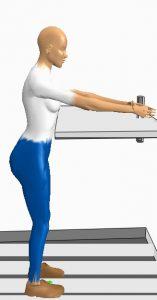
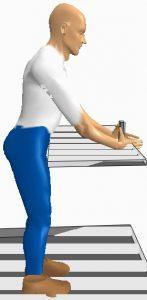 For very small workers, the risk is higher than “average”, because their arms are shorter, so the reach is more awkward.
For very small workers, the risk is higher than “average”, because their arms are shorter, so the reach is more awkward.
For taller workers, more bending is required.
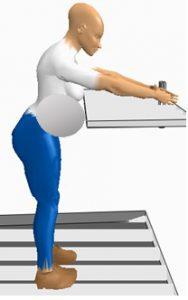 For workers who are obese or pregnant, the risk is higher, because they can’t get as close to the barrier. For this small worker, lifting the lighter load, even once every 4 minutes, puts the shoulders and lower back at risk of injury.
For workers who are obese or pregnant, the risk is higher, because they can’t get as close to the barrier. For this small worker, lifting the lighter load, even once every 4 minutes, puts the shoulders and lower back at risk of injury.
50 cm + 20 cm baby + 0.45 kg per hand + Once every 4 minutes = unacceptable
Ergonomists talk about “risk of injury” because we’re trained to think that way. But we could just as accurately say that long forward reach reduces the worker’s productivity, and quality of work output. Comfort, productivity and quality go hand in hand; when you’re uncomfortable, or in pain, you can’t work efficiently. But more than that, reaching further requires additional time, affecting productivity. And when work is done at a reach, accuracy is affected. (Don’t believe me? Try using your mouse with your arm outstretched, without resting your arm or palm on a surface.)
The next time you look at a job, pay attention to how far forward the worker has to reach, beyond the barrier (typically the edge of a bench or conveyor). If it’s more than 45 cm (18”), look for ways to bring the work closer, or reduce the obstructions.
If you’re not sure where to start, give us a call. We can do an assessment to help you pinpoint the problem, setting you on a path to improve safety, productivity, quality, and comfort.


